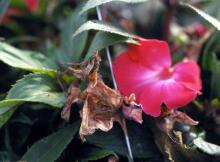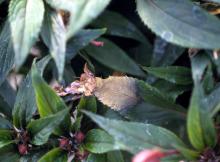See:
Greenhouse Plants, Ornamental - Gray Mold
Cause The fungus Botrytis cinerea, which colonizes dead, dying, and wounded plant parts. From these infections they can attack healthy impatiens tissues. Flower petals, of most any crop, are susceptible at any stage of development and can fall onto leaves starting new infections. A moist, humid environment is ideal for the pathogen's sporulation and spread. Conidia may come from many sources in and outside the greenhouse. It is found everywhere plants are grown and has a wide host range.
Symptoms Flowers develop necrotic spots, which in humid conditions, becomes fuzzy with brown to gray fungal growth. Leaves develop large, irregular tan to brown areas. Stems may rot if infected.
Cultural control
- Remove all dead and dying plant parts (particularly blossoms) on and around plants.
- Maintain a steady, relatively dry environment by keeping greenhouse humidity below 90%, increasing spacing between plants for good air circulation, and taking care not to splash water on foliage during watering. Heating the greenhouse at night (especially for zero or negative DIF) or venting around sunset may be necessary. Heating in the morning before sunup can also help prevent dew formation as air temperature increases faster than the temperature of plant parts. If using DROP or DIP for size control, do not let humidity rise above 90%.
- Spacing plants also allows better light penetration, reducing lower leaf senescence and thus helping reduce the amount of highly susceptible plant tissue.
- Place fans in greenhouse to get better air circulation.
- Avoid petal drop from hanging baskets above the crop.
Chemical control Best when used with cultural controls. Tank-mix and/or alternate products from different groups with different modes of action to prevent the buildup of resistant fungi. Limit the use of any one group during crop production.
- Astun at 10 to 17 fl oz/100 gal water. Group 7 fungicide. 12-hr reentry.
- Chipco 26019 FLO at 1 to 2.5 quarts/100 gal water. Do not use as a soil drench. Group 2 fungicide. 12-hr reentry.
- Decree 50 WDG at 0.75 to 1.5 lb/100 gal water. Group 17 fungicide. 12-hr reentry.
- Mancozeb-based products can be used as mixing partners and provide some protection. Group M3 fungicides. 24-hr reentry.
- Fore 80 WP at 1.5 lb/100 gal water plus a spreader-sticker.
- Protect DF at 1 to 2 lb/100 gal water plus 2 to 4 oz spreader-sticker.
- Mural at 4 to 7 oz/100 gal water. Group 7 + 11 fungicide. 12-hr reentry.
- OHP 6672 4.5 F at 10 to 14.5 fl oz/100 gal water plus another fungicide. Group 1 fungicide. 12-hr reentry.
- Orkestra at 8 fl oz/100 gal water. May discolor flowers if sprayed directly. Group 7 + 11 fungicide. 12-hr reentry.
- Pageant at 12 to 18 oz/100 gal water. Flowers may become discolored if open. Do not use with organosilicone-based adjuvants. Group 7 + 11 fungicide. 12-hr reentry.
- Palladium at 4 to 6 oz/100 gal water. Avoid excessive runoff to small plants, which may result in stunting and/or chlorosis. Group 9 + 12 fungicide. 12-hr reentry.
- Phyton 27 at 1.3 to 1.5 oz/10 gal water. Group M1 fungicide. 48-hr reentry.
- Spectro 90 WDG at 1 to 2 lb/100 gal water. Group 1 + M5 fungicide. 12-hr reentry.
- Terraguard SC at 2 fl oz/100 gal water on transplants. Do not use on plugs. Group 3 fungicide. 12-hr reentry.
Biological control
- LALStop G46 WG (Clonostachys rosea [formerly Gliocladium catenulatum] strain J1446) at 0.13 oz/1 gal water. Do not use with other products in the tank. 4-hr reentry. O
Reference Prichard, P.M., Hausbeck, M.K., and Heins, R.D. 1999. The Influence of Diurnal Temperatures on the Susceptibility of Bedding Plants to Gray Mold Caused by Botrytis cinerea. Plant Disease, 83:589.



